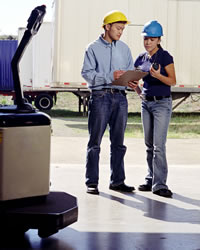
1. Use everyday language. When you have to include technical terms, explain what they mean, and write them on a board or flip chart so that employees can see the words as well as hear them.
2. Take education and language proficiency into account. For example, if you have non-English-speaking employees in your group, speak slowly and clearly, and point to equipment, labels, etc., that illustrate what you’re saying.
Also be sure to demonstrate procedures as you explain them. Let trainees know it’s OK to keep asking questions until they really understand your message.
3. Smile and be friendly. Be conversational. Don’t lecture.
Deliver fast and effective Environmental, DOT, and OSHA training with Environmental Training Library. Try it at no cost or risk. For a limited time, also receive a free special report. Download Your Free Report
3. Smile and be friendly. Be conversational. Don’t lecture.
4. Maintain a comfortable pace and moderate volume. Don’t speed through or drag out your words. Speak loudly enough to be heard in the back row, but don’t shout.
5. Speak with firmness and conviction. What you are saying is important so make sure they believe it. Use your tone to sell your message.
6. Be enthusiastic. Use your voice and body language to show you are glad you have the opportunity to talk about an important safety topic. Don’t seem bored or indifferent—would this attitude motivate you if you were the trainee? Probably not.
7. Create team spirit. Use words like "we" and "our" rather than "the company," "management," and "employees" whenever possible.
Download your FREE special report, Hazwaste Container Management: Where EPA Inspectors Look First, and receive a 30-day trial of Environmental Training Library at no cost or obligation. Download Your Free Report
8. Make eye contact. Very important! Don’t just read your notes. Look up and around the group as you talk. Try to make eye contact several times during the session with each trainee.
9. Combine words with demonstrations. Point to the machine or container label. Demonstrate the proper technique for PPE.
10. Stay focused. Keep on topic and on track to ensure that you have time to cover your content and to prevent confusion about the real point of the training session.
A Powerful Training Resource
Training: it’s hard work, and it can take so much time! Let BLR’s environmental experts do the work for you with Environmental Training Library. This extensive library of prewritten training materials helps you deliver EPA, RCRA, and HAZWOPER required training with ease.
In the start package along, you’ll have 120 training tools for your first 20 sessions. This includes PowerPoint® training meetings with audio, interactive classroom exercises, handouts, quizzes, and more! And with your regular supplements, (included at no additional cost) you’ll get 2 new PowerPoints each quarter to keep your training current!
Take a Free Trial today, and for a limited time, also download our Free Special Report, Hazwaste Container Management: Where EPA Inspectors Look First.
